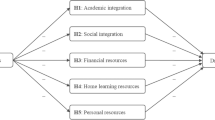Abstract
This study assessed the relative influence on attrition of students' precollege characteristics, their experiences and perceptions of the freshman year, and the interactions of sex, major, and racial or ethnic origin with those experiences and perceptions. A series of stepwise multiple regression analyses indicated that precollege traits are not significantly related to attrition, that integration in the academic systems of the institution may be more important than involvement in the social systems, and that certain interactions between precollege traits and freshman year experiences and perceptions may be the most important. The findings suggest that attrition reduction efforts may need to be focused on what happens to students after they arrive on campus, on academic areas, and perhaps on the development of selective plans designed for different kinds of students.
Similar content being viewed by others
References
Armor, D. J. Theta reliability and factor scaling. In H. L. Costner (ed.),Sociological methodology: 1973–74. San Francisco: Jossey-Bass, 1974.
Astin, A. W.Preventing students from dropping out. San Francisco: Jossey-Bass, 1975.
Cope, R. G. and Hannah, W.Revolving college doors: The causes and consequences of dropping out, stopping out, and transferring. New York: Wiley-Interscience, 1975.
Kamens, D. The college “charter” and college size: Effects on occupational choice and college attrition.Sociology of Education 1971,44 270–296.
Kaiser, H. F. Computer program for varimax rotation in factor analysis.Educational and Psychological Measurement 1959,19 413–420.
Kelly, E. F., Pascarella, E. T., Terenzini, P. T., and Chapman, D. The development and use of the Adjective Rating Scale: A measure of attitude toward courses and programs.Journal of Selected Abstracts in Science: Catalogue of Selected Documents in Psychology 1978,8 19–20.
Kerlinger, F. N. and Pedhazur, E. J.Multiple regression in behavioral research. New York: Holt, Rinehart and Winston, 1973.
Pascarella, E. T. and Terenzini, P. T. Patterns of student-faculty informal interaction beyond the classroom and voluntary freshman attrition.Journal of Higher Education 1977,48 540–552.
Rootman, I. Voluntary withdrawal from a total adult socializing organization: A model.Sociology of Education 1972,45 258–270.
Spady, W. Dropouts from higher education: An interdisciplinary review and synthesis.Interchange 1970,1 64–85.
Spady, W. Dropouts from higher education: Toward an empirical model.Interchange 1971,2 38–62.
Stern, G. G.People in context. New York: Wiley, 1970.
Terenzini, P. T. & Pascarella, E. T. Voluntary freshman attrition and patterns of social and academic integration: A test of a conceptual model.Research in Higher Education 1977,6 25–43.
Tinto, V. Dropout from higher education: A theoretical synthesis of recent research.Review of Educational Research 1975,45 89–125.
Author information
Authors and Affiliations
Rights and permissions
About this article
Cite this article
Terenzini, P.T., Pascarella, E.T. The relation of students' precollege characteristics and freshman year experience to voluntary attrition. Res High Educ 9, 347–366 (1978). https://doi.org/10.1007/BF00991406
Issue Date:
DOI: https://doi.org/10.1007/BF00991406




